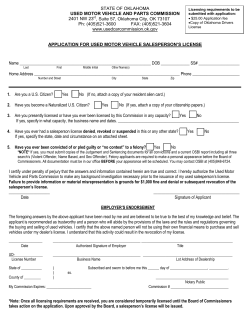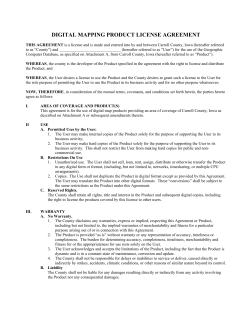
How to Create a Deployment Share Using MDT 2010 Update...
Author: Rusty Hann URL: www.rustyhann.com How to Create a Deployment Share Using MDT 2010 Update 1 I am not responsible for your actions or their outcomes, in any way, while reading and/or implementing this tutorial. I will not provide support for the information herein. If you do not understand something, figure it out on your own. If you need help figuring it out, use Google to solve your problems. Introduction A deployment share is the central storage point for all files, drivers, packages, applications, and data for an operating system deployment. The deployment share consists of two parts. The first is the folder where files and data are stored on the hard drive. This folder should not be located on the system drive, which is usually C:\. You can either partition your hard drive into separate partitions, or install a second hard drive. The second part of a deployment share is the network share which points to the folder on the hard drive where deployment share data is stored. This is a standard Windows networking share, with the exception that it should be an administrative share to prevent standard users from accessing, and browsing through the network, deployment data. The share permissions should be set to Everyone - Full Control, and access to the deployment files should be controlled with NTFS permission. When creating a deployment share it is imperative that you understand exactly how you want to deploy the operating systems you attach to it. You need to thoroughly understand how users will access and use the PCs you are deploying. You must also understand how you will license your operating systems and what software you will install with those operating systems and how that software will be licensed. If you require any custom drivers for the clients you will be deploying to, you must also have those on hand . The key to creating a successful deployment share, and successfully deploying client operating systems, is to prepare ahead of time. This work is licensed under the Creative Commons Attribution-NonCommercial-ShareAlike 3.0 Unported License. To view a copy of this license, visit http://creativecommons.org/licenses/by-nc-sa/3.0/or send a letter to Creative Commons, 171 Second Street, Suite 300, San Francisco, California, 94105, USA. Author: Rusty Hann URL: www.rustyhann.com Before You Begin 1. Open the Deployment Workbench by clicking: Start Menu -> All Programs -> Microsoft Deployment Toolkit -> Deployment Workbench Steps 1. Right click the Deployment Shares node and select New Deployment Share. NOTES: This work is licensed under the Creative Commons Attribution-NonCommercial-ShareAlike 3.0 Unported License. To view a copy of this license, visit http://creativecommons.org/licenses/by-nc-sa/3.0/or send a letter to Creative Commons, 171 Second Street, Suite 300, San Francisco, California, 94105, USA. Author: Rusty Hann URL: www.rustyhann.com 2. You will now specify a Deployment share path. The Deployment share path should not be located on the system drive , in most cases C:\. You will need to either partition your drive into two separate partitions, or install a second hard drive (virtual or physical) to store your deployment shares on. Enter the path to the deployment share you wish to create, or browse to the path, and click the Next button. NOTES: I have a second virtual hard drive installed on this machine, F:\. I have chosen to store my deployment share at, F:\Win7Ent-x86. You can rename the deployment share if you wish. It will ease the management of your MDT 2010 U1 deployments if you name your deployment shares, the file folders they are located in, and the network shares that allow access to them the same name. As an example, my deployment share will be located at, F:\Win7Ent-x86, the folder located on the F:\ drive where the deployment share files are located is labeled, "Win7Ent-x86", and the share name I will assign the network share will be, "Win7Ent-x86$". I will be sharing the deployment share files as an administrative share (donated by the '$' at the end of the share name) to prevent standard users from being able to access my deployment files. It is also a wise decision to descriptively name your deployment shares. I name and organize my shares based on the operating system that is being deployed. This share will be deploying 32bit Windows 7 Enterprise, hence the name Win7Ent-x86. This work is licensed under the Creative Commons Attribution-NonCommercial-ShareAlike 3.0 Unported License. To view a copy of this license, visit http://creativecommons.org/licenses/by-nc-sa/3.0/or send a letter to Creative Commons, 171 Second Street, Suite 300, San Francisco, California, 94105, USA. Author: Rusty Hann URL: www.rustyhann.com 3. Name the share which will allow network access to your deployment share files and click the Next button. It is highly recommended that you place a '$' at the end of your share name to designate the share as an administrative share. NOTES: An administrative share is a share which standard users cannot see when browsing the network. To make a network share an administrative share, place an '$' at the end of the share name. If you wish to access this share, you will have to manually enter the UNC path, such as \\servername\sharename$. You will also have to have the proper NTFS and Share permissions to access this share. If you are not logged in as a user with those privileges, you will be prompted for the username and password of a user who does. This work is licensed under the Creative Commons Attribution-NonCommercial-ShareAlike 3.0 Unported License. To view a copy of this license, visit http://creativecommons.org/licenses/by-nc-sa/3.0/or send a letter to Creative Commons, 171 Second Street, Suite 300, San Francisco, California, 94105, USA. Author: Rusty Hann URL: www.rustyhann.com 4. Give your deployment share a descriptive name and click the Next button. NOTES: The most important thing you can do to help yourself while creating a deployment share is to keep yourself organized. More specifically, you need to have a naming convention in place in order to systematically and efficiently organize the files and folders in your deployment share. In this description, I have taken the shortened name, "Win7Ent-x86", and expanded it into its full name, "Windows 7 Enterprise x86". This work is licensed under the Creative Commons Attribution-NonCommercial-ShareAlike 3.0 Unported License. To view a copy of this license, visit http://creativecommons.org/licenses/by-nc-sa/3.0/or send a letter to Creative Commons, 171 Second Street, Suite 300, San Francisco, California, 94105, USA. Author: Rusty Hann URL: www.rustyhann.com 5. You will be asked whether or not you want to capture an image when deploying your operating systems to a new computer. I answer no by removing the checkbox. Remove the checkmark next to, "Ask if an image should be captured", and click the Next button. NOTES: I prefer to make a separate deployment share dedicated to testing an image capture. I use this deployment share when capturing a new image to make sure that everything is running smoothly. If the image captures correctly, and subsequently deploys correctly, I will then recapture that image to the deployment share it was intended for. I never let a deployment share ask to capture an image. This is only done by myself, an IT employee, and should never be done by non-technical staff as I see it. I also only capture an image using the Sysprep and Capture task sequence, which will be covered in the tutorial, "How to Sysprep and Capture a Custom Image Using MDT 2010 U1". I only capture custom images that will be deployed to new computers. Capturing and restoring the state of a computer which is being upgraded can be done with MDT 2010 U1, but is beyond the scope of this tutorial. This work is licensed under the Creative Commons Attribution-NonCommercial-ShareAlike 3.0 Unported License. To view a copy of this license, visit http://creativecommons.org/licenses/by-nc-sa/3.0/or send a letter to Creative Commons, 171 Second Street, Suite 300, San Francisco, California, 94105, USA. Author: Rusty Hann URL: www.rustyhann.com 6. DO NOT place a checkmark next to, "Ask user to set the local Administrator Password". Click the Next button. I am assuming this is for a standard business environment in which users do not have access to the local administrator account. If you prefer to grant users access to the administrator account, you can place a checkmark in the aforementioned checkbox. NOTES: If you are deploying a large number of machines, and wish them all to have a standardized local administrator password, you can set this value in the customsettings.ini file. For more information refer to, "How to Configure the customsettings.ini File in MDT 2010 Update 1". This work is licensed under the Creative Commons Attribution-NonCommercial-ShareAlike 3.0 Unported License. To view a copy of this license, visit http://creativecommons.org/licenses/by-nc-sa/3.0/or send a letter to Creative Commons, 171 Second Street, Suite 300, San Francisco, California, 94105, USA. Author: Rusty Hann URL: www.rustyhann.com 7. DO NOT place a checkmark Next to, "Ask user for a product key". Click the Next button. Again, I am assuming this is a deployment scenario in a business setting. If you wish to individually enter product keys, you may place a checkmark Next to, "Ask user for a product key". NOTES: You can also assign a product key to every machine you deploy from this deployment share, such as when implementing a MAK key. This can be done by using the, "customsettings.ini", file. For more information refer to, "How to Configure the customsettings.ini File in MDT 2010 Update 1". This work is licensed under the Creative Commons Attribution-NonCommercial-ShareAlike 3.0 Unported License. To view a copy of this license, visit http://creativecommons.org/licenses/by-nc-sa/3.0/or send a letter to Creative Commons, 171 Second Street, Suite 300, San Francisco, California, 94105, USA. Author: Rusty Hann URL: www.rustyhann.com 8. Review your selections for this deployment share and click the Next button. NOTES: This work is licensed under the Creative Commons Attribution-NonCommercial-ShareAlike 3.0 Unported License. To view a copy of this license, visit http://creativecommons.org/licenses/by-nc-sa/3.0/or send a letter to Creative Commons, 171 Second Street, Suite 300, San Francisco, California, 94105, USA. Author: Rusty Hann URL: www.rustyhann.com 9. The deployment share will now be created. When the wizard is finished, click the Finish button. NOTES: This work is licensed under the Creative Commons Attribution-NonCommercial-ShareAlike 3.0 Unported License. To view a copy of this license, visit http://creativecommons.org/licenses/by-nc-sa/3.0/or send a letter to Creative Commons, 171 Second Street, Suite 300, San Francisco, California, 94105, USA. Author: Rusty Hann URL: www.rustyhann.com WRAP UP 10. Take a look at the deployment workbench. If you expand the Deployment Shares node, you will see the deployment share you just created. The descriptive name will be shown first, with the physical location of the deployment share folder in parenthesis. You will also see headings for Applications, Operating Systems, Out-of-Box Drivers, Packages, Task Sequences, and an Advanced Configuration Node. NOTES: This work is licensed under the Creative Commons Attribution-NonCommercial-ShareAlike 3.0 Unported License. To view a copy of this license, visit http://creativecommons.org/licenses/by-nc-sa/3.0/or send a letter to Creative Commons, 171 Second Street, Suite 300, San Francisco, California, 94105, USA. Author: Rusty Hann URL: www.rustyhann.com 11. If you open the Share and Storage Management MMC, by clicking: Start Menu -> Administrative Tools -> Share and Storage Management You will see the network share created when the deployment share was created. NOTES: This work is licensed under the Creative Commons Attribution-NonCommercial-ShareAlike 3.0 Unported License. To view a copy of this license, visit http://creativecommons.org/licenses/by-nc-sa/3.0/or send a letter to Creative Commons, 171 Second Street, Suite 300, San Francisco, California, 94105, USA. Author: Rusty Hann URL: www.rustyhann.com Troubleshooting • • • Having an organized naming structure is ABSOLUTELY NECESSARY to creating and maintaining a deployment share. It is highly recommended to make the network share associated with your deployment share an administrative share to keep standard users from being able to access deployment files. Understand how you will license the operating systems deployed from your deployment share BEFORE you answer the questions in the wizard. I am not responsible for your actions or their outcomes, in any way, while reading and/or implementing this tutorial. I will not provide support for the information herein. If you do not understand something, figure it out on your own. If you need help figuring it out, use Google to solve your problems. This work is licensed under the Creative Commons Attribution-NonCommercial-ShareAlike 3.0 Unported License. To view a copy of this license, visit http://creativecommons.org/licenses/by-nc-sa/3.0/or send a letter to Creative Commons, 171 Second Street, Suite 300, San Francisco, California, 94105, USA.
© Copyright 2025



















